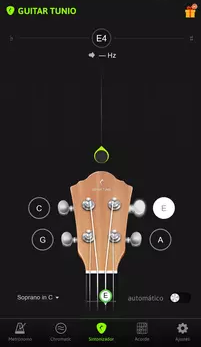How To Tune A Ukulele
The first thing you need to do before playing any instrument is to get it in tune! It doesn’t matter how well you play, if the ukulele is out of tune, it will not sound right. We recommend you tune up your ukulele every time you play.
Standard Ukulele Tuning
Most soprano, concert, and tenor ukuleles have their 4 strings tuned GCEA: the G below middle C (low G), middle C, E, and A. Each string is tensed or loosened with a tuning peg at the top of the fretboard. The lower left of the 4 tuning pegs tunes the G string, the peg above it tunes the C string, the upper right peg tunes the E string, and the peg below it tunes the A string. The strings are numbered from the furthest away to the closest to you, assuming you play the ukulele right-handed. The first string is the A string, the second the E string, the third the C string, and the fourth the G string.

The G and C strings are strung in one direction and the E and A are strung in the opposite. This means when you’re tuning, you move the pegs for G and C clockwise to lower the pitch and counterclockwise to raise it. However, E and A are the opposite of this: turn the peg clockwise to raise the pitch and counterclockwise to lower it.
How To Tune A Ukulele
It’s really easy to tune your ukulele with the ukulele tuner in Guitar Tunio. Here is how to tune up your ukulele with Guitar Tunio.

- Step 1: Select a ukulele tuning
- Step 2: Keep the ukulele close to the microphone and play the string.
- Step 3: Look at the tuner and adjust the string
The Guitar Tunio will tell you whether the note is flat (too low) or sharp (too high). If the needle is to the left that means the pitch is too low, you need to tighten the string. If the needle is to the right that means the pitch is too high, you have to turn the tuning peg to loosen the string. Watch the tuner as you do this and adjust accordingly. Once you get the needle in the middle, your string is in tune – move up to the next string.
- Step 4: Repeat the process for the remaining strings
Good luck!






